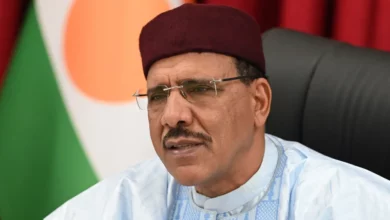A few days ago, 9000 workers at the Naga Hammadi aluminum factory in Upper Egypt staged a protest, demanding that the Egyptian government raise the minimum wage to LE1200, and calling for a withdrawal of confidence from their official trade union committee.
Shortly thereafter, a number of retired workers went to the Ministry of Manpower in an effort to form an independent trade union that would defend their rights.
Meanwhile, workers from eight different Egyptian governorates have been sitting-in before the parliament building for weeks, also articulating their own grievances.
These demonstrations reflect the labor scene in Egypt today and provide some indications about what the future may hold. In each case, workers have confronted the legislative and executive powers of the regime to demand a higher national minimum wage and the establishment of independent trade unions which can represent them.
The real trigger for the wave of labor strikes that we are now witnessing took place on 7 December 2006, when the textile workers of the state-owned Mahalla Spinning and Weaving Company went on strike demanding that they receive a two-month bonus in accordance with a previous ministerial decree.
People at the time were puzzled to see 24,000 workers protesting for a mere LE450 per worker, wondering if such a meager sum warranted demonstrations for three whole days.
But the December 2006 strike was a sign of where the Egyptian labor movement was heading, as it broke the state of tranquility that marked the movement since the mid-1990s. The female workers of the Mahalla company initiated the strike, and have become remembered for their well-known chant, “The women are here, where are the men?” Their participation was an initial sign of the labor movement’s ability to challenge widespread social perceptions that women are unfit to hold positions of authority or lead a labor movement. Women workers would remain a driving force behind many other labor protests ever since, such as the real estate tax collectors’ sit-in in 2007 and the demonstrations taking place before parliament today.
The labor movement today is well aware that it can defeat long-held perceptions. This awareness first began to surface as workers started demanding the right to form independent trade unions, and refused to remain held in the grips of the official state-run Egyptian Trade Union Federation (ETUF).
The timing of the Mahalla strike was pivotal, coming just a few weeks after trade union elections. It succeeded in challenging the rigged results of the elections, as workers felt their official trade union, affiliated with the ETUF, would not defend their rights. As such, they withdrew confidence from the union and requested to form a separate organization that would truly represent their interests. When the ETUF ignored their request, workers resigned from their elected positions.
The clash with the ETUF paved the way for the subsequent formation of various independent unions. Workers who felt they were abandoned by their official unions felt compelled to organize themselves autonomously. This was the beginning of a trend that was slowly but surely growing in the labor movement.
The freedom to form independent unions should not only be considered as an achievement for organized labor, but rather as an assertion of essential democratic rights, even if the labor movement has not officially identified itself as a movement for democracy and political reform. The fact that it was able to protest against and successfully remove the restrictions imposed on it has been its most important democratic gain, benefiting hundreds of thousands, if not millions, of workers, even though the movement started with simple demands for bonuses and meal allowances.
Then came the demand for a national minimum wage, a significant development in the recent history of the labor movement.
The Mahalla workers went on another three-day strike in September 2007, this time with new demands. That same year, real-estate tax collectors began a strike that would last for three months, demanding wage parity with their counterparts in the Ministry of Finance, which would mean an increase of 300 percent in their salaries. The 10,000 tax employees protesting before the Council of Ministers succeeded in making the finance minister agree to their demands.
Then 12,000 workers of the Mahalla Spinning and Weaving Company again staged protests on 17 February 2008, demanding that the national minimum wage be raised to LE1200 per month. This occurred one day before the state-appointed National Council on Wages convened to discuss the issue. The workers’ timing was intended to send a message to the council. It was the first time that workers made demands not only for themselves, but for all the workers of Egypt.
The workers also for first time insisted that they wanted their salaries to surpass the poverty line, which is internationally estimated at US$8 per day for a family of four. Workers found that asking for incentives and social allowances wasn’t enough, as these were funded by the government raising prices of fuel and basic commodities, which in turn devalued their wages. So they presented their case within a bigger context.
This was an important development in the course of the labor movement. Demands moved from uniting workers to changing labor relations in Egypt altogether. Workers argued that wages should no longer be subject to an employer’s whim nor should wage standards be low just because unemployment was forcing jobless people to accept whatever they could work for.
In response to growing pressure, Egypt’s administrative court recently ruled that the state must set a national minimum wage in accordance with rising prices. Although this demand for a minimum wage has not yet been achieved, the fact that it was raised in many strikes, and that the administrative court issued this ruling suggests that the workers may well win this battle soon.
The successive labor strikes over the past three years should not be considered sporadic, even if they seem so at a first glance. Despite the fact that they have not been organized by a unified body, these strikes are indeed linked to each other. Perhaps the factor that links them most is the government’s economic policies, which seek to attract investors by relieving them of obligations toward those who they employ, therefore placing a higher social and economic burden on workers. The fact that many workers are protesting in front of government institutions indicates that they want to directly confront the main source of their grievances.
Egypt’s recent wave of labor strikes has achieved gains far beyond mere bonuses and meal allowances. It has succeeded in establishing a new force in Egyptian society. Government policies in the 1990s, such as rapid privatization, have had a damaging long-term impact; they were implemented with little concern for the working men and women who would be most affected by such decisions–as if the government was the only player on the field. Today, it is no longer possible to talk about democratic reform without mentioning the gains achieved by labor groups, be they independent trade unions or ad-hoc strike committees. Nor is it possible to talk about “change” without taking into account the rights of workers and the unequal distribution of wealth.
The gains of the labor movement look great from the perspective of what has actually been achieved, yet still very small from the perspective of to what is to come.
This story is part of Al-Masry Al-Youm’s ongoing series on labor for May Day 2010.




